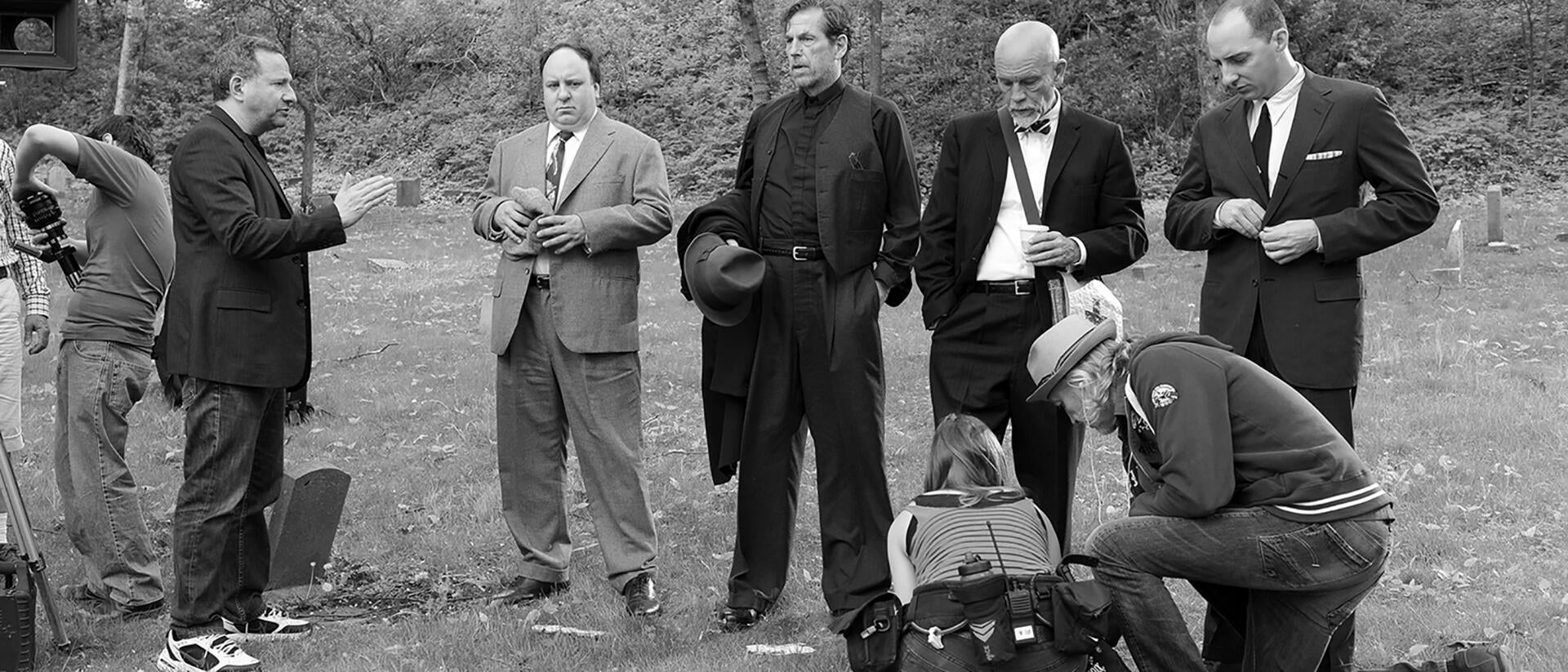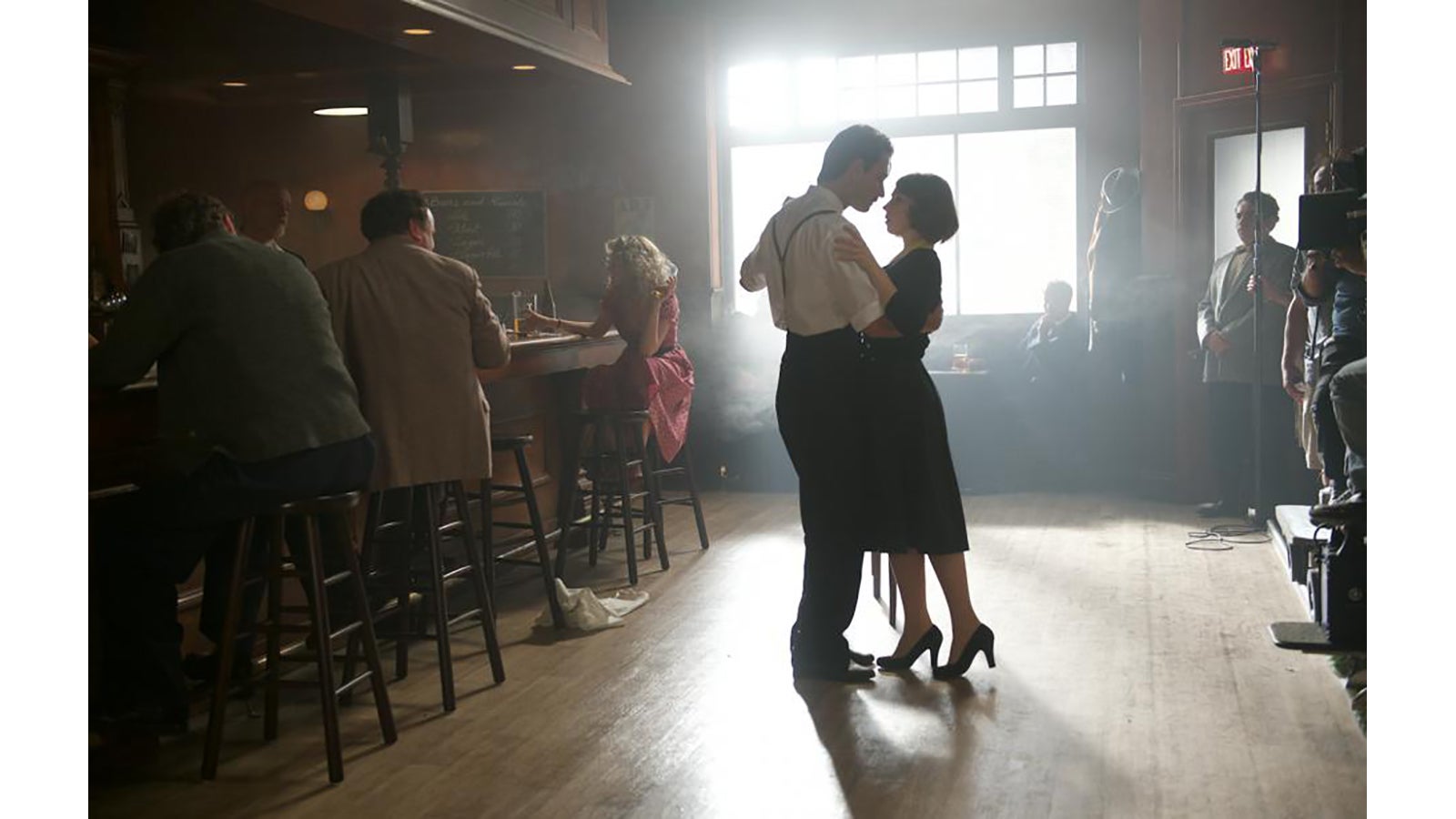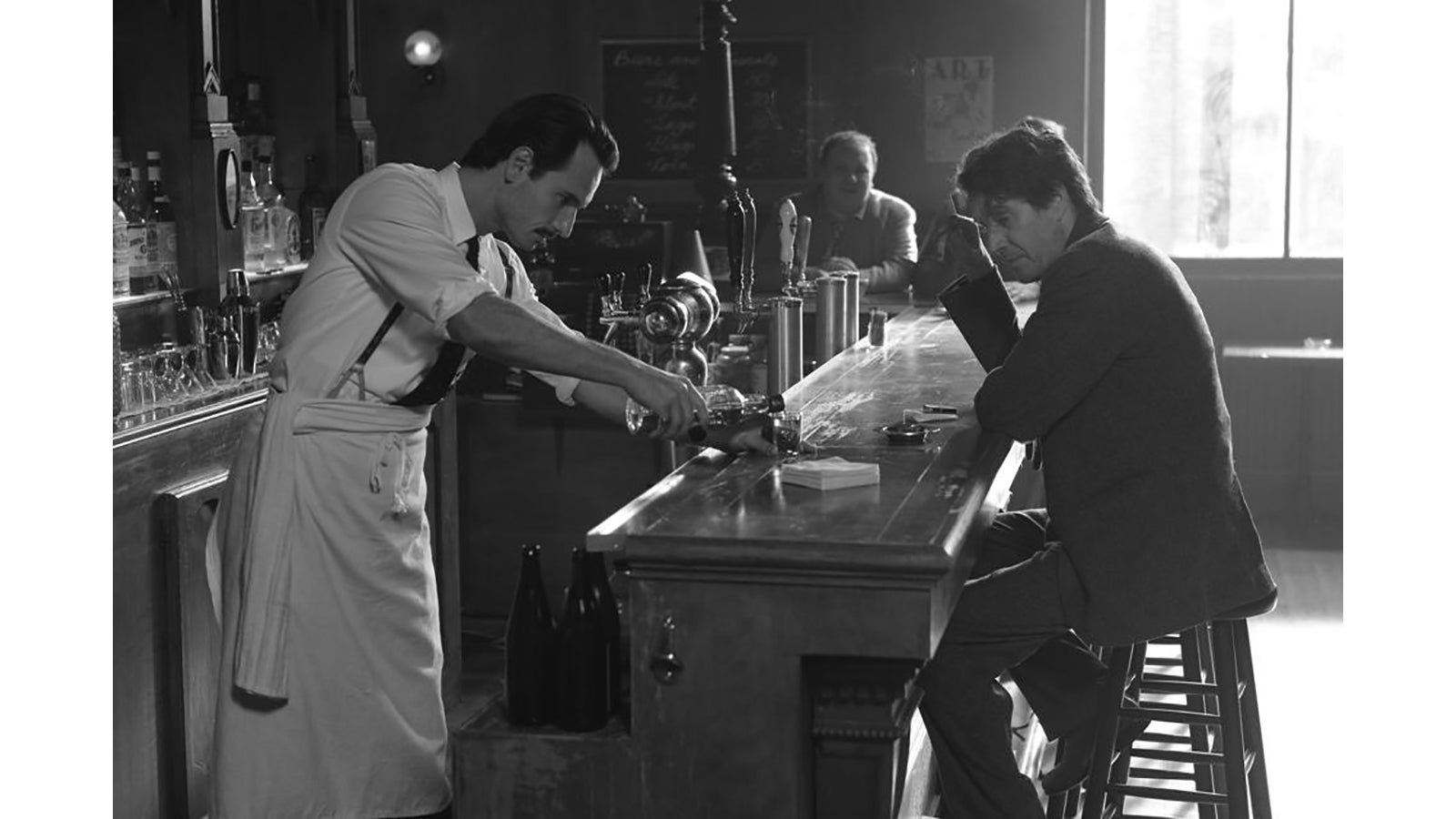
05-21-2021 - Case Study
The DP - Gaffer Relationship - A Conversation of Collaboration - Part 2
By:
Writer, director and DP Steven Bernstein, DGA, ASC, WGA and DP and gaffer Antal Steinbach discuss the DP / Gaffer relationship in the context of their collaboration on Last Call, a feature film written and directed by Bernstein and starring John Malkovich. Steinbach was DP of Last Call.
Antal Steinbach was also gaffer on the U.S. portion of the Marvel film Black Widow, shot on VENICE and coming out July 9th, 2021.
Part 1 of this conversation can be read at this link: https://sonycine.com/articles/the-dp---gaffer-relationship---a-conversation---part-1/

Rodrigo Santoro in the bar with Zosia Mamet
Steven:
In terms of performance, once an actor gets into a zone you want to keep them there. Ultimately, everything is about facilitating that performance once the directing starts. I was a cinematographer so I love the lighting and I loved the lighting that you did on this film (Last Call), and it contributes mightily to the mood.
If you look at the bar, it's on a stage and for the most part it doesn't look like it's on a stage and it's got a lot of atmosphere. Last Call was meant to be a surreal film so you struck that happy balance between the real and the surreal, which is what I was looking for. I was much influenced by the British television dramas of the 1950s, so I wanted to have a certain quality of look and through the combination of lighting and smoke, which we'll talk about in a second, you created that, I think, quite remarkably. The clothing and the backgrounds and the back lighting all created the separation.
The speed at which you did that was hugely valuable to me because it meant that the actors once there could just keep going. I would do a take and then I didn't want people to jump in and make adjustments, you made them secretly which is great. I wanted to just keep going because Rhys and Romola and John would find a rhythm and I wanted to keep it going. It was great that you were able to light so quickly and facilitate that.
Tell me a bit about smoke and your feelings about it, and why we used smoke on this film? How did it help you?
Antal:
Well, I think the smoke was a huge help for many reasons. Number one, it created some atmosphere in the bar. We had to use lenses that we could afford, so they were a little too sterile and crisp. So besides diffusing using diffusion filters, the smoke really helped un-sterilize, or soften, those lenses and would pick up light and help open up the contrast a bit to be able to read into some of the shadows, so it was a huge help. Film beauty is not always about the sharpness of the image and often it’s quite the opposite.
I've definitely learned when using smoke. The person who's doing it really has to be good at it because if not and it’s over done, you have the entire company who's ready to shoot and actors who are in character and ready to go and everyone is waiting for haze to dissipate. It’s a lot of pressure on the DP.
Steven:
Haze is a double edged thing, because it does make films look better. It makes things look more real. Like you said, sharp lenses can have too much edge to them, so I'm glad you used the smoke because it softened it up. When using color, it reduces color saturation, it creates dimensionality and it makes the set look a little more real.
But you are so right, when you're ready to go and the actors are there and the DP says "hold on, the smoke looks a bit thick," the pressure on the DP is intense. The DP is thinking "I know they want to go, but if they go it's going to look bad later, but I'll be the hero today and they won't realize for a day or two that they went while it was too smoky and I'll be fine." As a DP you’re almost tempted to say, "yes, go ahead and roll" because the director is shooting daggers at you. But if the smoke is too thick, it looks like it was generated by a fog machine, and if it's too thin it's not having the effect you want. So I guess the idea is to get it just right so it's there but the audience doesn't notice it. It can't be swirling. So it's a tricky thing and it absorbs a lot of time, but it definitely does make the film look better.
Tell me about the dance sequence and I want you to talk a little bit about the use of multiple cameras, your feelings about that generally and about the dance sequence in particular.
Antal:
Well, on Last Call we were always shooting with two cameras when we could afford it and for the dance sequence we used three cameras. Two cameras were on dollies and we had a Steadicam. There was a lot of choreography to cover. It really was a tough scene.
It was early in production as well where we were still getting to know each other's personalities and I was learning how to motivate my crew without being pushy. I hope I didn't show it, but it was controlled chaos.
I was really relying heavily on our focus pullers, who were excellent, and I gave them very shallow stops for this.

Rodrigo Santoro dancing with Zosia Mamet
Steven:
What you did was great because I wanted the actors coming in and out of focus. The multiple cameras were great because, as you said, it was controlled chaos and that was the intention. Sometimes on set it's difficult to let go of precision in the pursuit of something bigger than precision, which is art.
So in a scene like that one it's impossible to know everything that you want to get until you're shooting it. I find in shooting action or something dramatic like that, multiple cameras are great, because then you can let things run where they might. It’s found art rather than planned art.
As you move the camera you suddenly find a really cool shot or angle you didn't realize was there. And when dancers are spinning and doing a tango sometimes a Steadicam just gets in a position and finds something magical. If I had tried to plan that out and said "go here, at this point and this light will be there," we wouldn't have gotten that spontaneity and energy.
And, if I'm not mistaken, at one point I put a camera on my shoulder and we were just shooting everything that we could while Zosia and Rodrigo did that incredible dance. I remember with the window that opened out into the street you had put light over the top of that set, so it seemed as if the light was coming from that window. So at one point Zosia is back-lit, and when you backlight smoke it stands up a lot more and the inclination is to think it won't match everything else. But in that sequence in the film where you see Zosia against the window and the atmosphere is quite smoky what happens is the audience is emotionally engaged, so they don't actually care that one shot is a little bit smokier than the other, and dramatically, it works. You wouldn't want her lit in any other way, because she's crossing a bridge at that moment, it's a big emotional moment in the movie, so it's beautifully photographed. Or I should say, correctly photographed for that moment.
I thought Romola was beautifully photographed throughout. Do you remember what your plan was for lighting Romola in those close ups, particularly when we were shooting her in color rather than black and white?
Antal:
Well, to be honest, she was really easy to light. She just photographs really well. I definitely used soft lighting for her and made sure that the back light wasn't ever too heavy, because those beautiful curls of hers wouldn't have felt right otherwise. So I used soft three-quarter light and I always had a soft key light off to the side, almost a forty-five and then I would use a very soft light a bit closer to the camera to continue that route. So it looked like it was the same source, yet it just catches her a little bit in the eye and just smoothed over to the two soft sources, and it worked beautifully especially for her.
Steven:
So you wrapped the light around. You'd have a light that would appear to be coming from the side, but you kind-of cheated. Because even though the source light would seem to come from one side, you'd have a light almost directly in front to fill the eyes in. So the audience would see the light coming from one direction, but you would cheat it, so you'd get a little kick under those eyes so they would glow. I loved that because I feel performance lives in the eyes, so I love the fact that you were lighting the eyes all the time and we could see that performance, which I thought was very, very cool.
One of the other advantages of shooting on a stage is the floating walls. We didn't only shoot the bar there, we also shot the train station on the stage and then we changed the bar and we made it into a restaurant if you recall. How did you manage all that?
Antal:
Honestly, the only way I could have managed that was because of the grid we put up. I had points where we could quickly go up without needing a lift. It was purposely built low enough so that we could reach it with a ladder. So if we needed to put something up or make an adjustment we could do so. We used par cans and various very old stage lights that have been around since probably the ‘20s. They looked like old head lamps from a car in a housing. We would hang them and they gave us hits here and there to sell it.
We couldn’t afford more than one sound stage. So we would keep the lights rigged and redress the sets. The grid saved us a lot of time when we did this. It probably didn’t take more than two hours to switch out the lighting from one set to the next.

Rhys Ifans as author Dylan Thomas
Steven:
So how did you cheat it to make it look different enough to make sure the audience didn't recognize it the fact we were using a lot of the same set pieces?
Antal:
What helped sell it the most was your blocking of the scenes. We found angles that we hadn’t really used in the bar scenes. In the restaurant scenes, when we had two people seated, we shot up against the wall which we didn’t really do in the bar scenes. I also made it brighter outside than I had previously done and obviously the art department redressed the set.
Steven:
Right. So tell me about the greenscreen work we did on this film. How do you light green screen? And without a D.I.T. how hard was it to do the green screen on the film and make it match?
Antal:
Well, I light digital green screen as I did with film. Unless there's an effects supervisor who says we can go with it as it is, I really do my best to make it as even as possible. I have it just under key as far as stop incident, depending on if it's chroma or digital green screen (digi). Digi is now more popular. A few years ago, when we shot Last Call, digi wasn’t really being used so we used chroma which absorbs a lot of the light. A lot of the time with digi you’re taking away the light because it's so pronounced. We used to dial into the chroma channel to be able to key it out, now they've taken out one step and they're able to do it with something that's a little brighter. I guess I still like chroma. I've had problems with digi when shooting outside and everybody's in full shade and we have no lights on it and it feels like it's screaming at you. And it contaminates the shadows.

Rhys Ifans as Dylan Thomas and Rodrigo Santoro tending bar
Steven:
So tell me, about the hand-holding and the use of dollies on the film. Tell me about the camera movement generally?
Antal:
You were very clear that you wanted the cameras on dollies with soft wheels so we could lay out Masonite and make moves without having to put down track. The cameras were on gear heads, not fluid heads, because in the hands of a good operator they give you the smoothest most controlled moves you can get. We also had a remote head. That’s how we did almost everything except the dance sequence and some of the exterior scenes.
Steven:
The fact you're using Masonite with soft wheels means the camera can be on a dolly but can move pretty freely to find the exact angles you want. So is that a method you learned to like?
Antal:
Most definitely, because you can lay out Masonite, you tape them together, you put soft wheels on the dolly and basically you have the freedom of crabbing, going front, back, left, right, and diagonal. You can put the dolly in round and you can do round sort of banana shots. With a good dolly grip who knows how to do it, it really gives you the flexibility to do complex moves seamlessly and quickly. It gives you a lot of freedom.
Steven:
Briefly, I know you’re mainly a cinematographer now but I know you went back temporarily to being a gaffer for Gabriel Beristain on Black Widow.
Antal:
Yes. Gaby called me to gaff for him on the U.S. portion of the Marvel film Black Widow. It was mostly shot in the U.K. at Pinewood Studios and all across Europe. really. It was quite extensive. They had been shooting months before they even came to finish up in the U.S. in Atlanta. It was fun.
Steven:
What a difference between a huge budget film like Black Widow and our little film we shot in Canada with a very small budget. Different challenges, very different productions, but the skill sets that one requires, the leadership skills, understanding what you can and can't do with what’s available to you are all the same, I think.
Antal:
Yes, at the end of the day the job doesn't change, the tools do, and the personalities do. You’re always working fast and making adjustments for something unforeseen. At the last minute the director might put an actor somewhere that wasn't really talked about, and big budget or not, you need to make it work, and you need to make it work in a very timely fashion. When actors are on set you have to be ready to shoot. The toys change, the size of the crew changes, but ultimately Black Widow in many ways was like any other film.
Steven:
Fantastic. Antal, it was a delight collaborating with you and speaking with you today, thank you.
About the author:
Steven Bernstein, DGA, ASC, WGA is an ASC outstanding achievement nominee for the TV series Magic City. He shot the Oscar winning film “Monster,” “Kicking and Screaming,” directed by Noah Baumbach, “White Chicks” and some 50 other features and television shows. The second film he wrote and directed, “Last Call,” stars John Malkovich, Rhys Ifans, Rodrigo Santoro, Zosia Mamet, Tony Hale, Romola Garai and Phil Ettinger, released late in 2020 in to theaters in selected cities.
Steven can be followed at Stevenbernsteindirectorwriter on instagram where he regularly posts short insights and illustrations about filmmaking.




